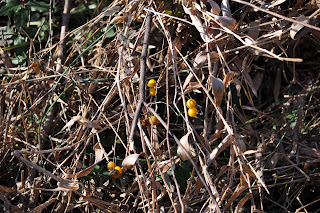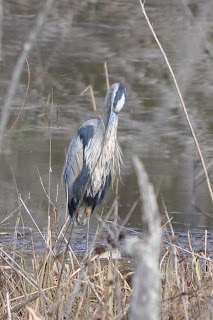When the leaves have dropped it is a good time to discover what has been hiding behind the foliage. Nests of all kinds are suddenly in plain sight. But not only birds build their homes in the bushes and trees. Insects also create places to deposit the next generation.
I have been told that this insect casing (above) is most likely that of a praying mantis. I have seen several handsome specimens of praying mantis in this area, so maybe my sources are correct.
While we are looking for signs of insects, galls are easy to spot in the winter. Galls are created by insects in search of food or as protected places for development between stages of life. In the fields around the parking lot you can find many examples of goldenrod galls. Further along into the island, if you turn right onto the mulched path, there is an infestation of oak galls. These grow on, you guessed it, oak trees. There are many oak seedlings along the path. Many of them have clusters of oak galls.
Not a gall, but easily seen in the winter, you might spot some black knot fungus on a cherry tree. Not a good thing to see. Once the fungus attacks a cherry tree, the wood is no longer of any value. Speaking of cherry trees...as you walk into the park, look for the 2 large downed cherry trees on the right and another on the left side of the path. July's derecho took these beauties down. What a shame. They were lovely trees.
Winter is great time to observe the various types of fungi that grow in the forest. This tree is covered with a shelf fungus. You'll often see it on downed, dead trees, but it also grows on what might look like a healthy tree. A tree with shelf fungus is not a healthy tree! The fungus emerges from inside the tree signalling that the processes of decay have already started. Look carefully. Shelf fungus grow parallel to the ground. If an infested tree falls over, the shelf fungus will slowly re-orientate itself until it is again parallel to the ground.
 There is still a little green to be seen in the winter woods. The mountain laurel bushes are evergreens. Make sure you come back in late spring to enjoy the flowers. Red cedar stays green. Not my favorite tree, but the birds need the cover and eat the berries. Another touch of green can be found in the honeysuckle vines. Another "not my favorite" plant. Look and see how the honeysuckle wraps itself round young trees, strangling them.
There is still a little green to be seen in the winter woods. The mountain laurel bushes are evergreens. Make sure you come back in late spring to enjoy the flowers. Red cedar stays green. Not my favorite tree, but the birds need the cover and eat the berries. Another touch of green can be found in the honeysuckle vines. Another "not my favorite" plant. Look and see how the honeysuckle wraps itself round young trees, strangling them.
One more thing to look for in the winter woods is berries. Many have already been eaten by the birds and critters, but look, you'll see a few. Along the bridge near the parking lot I found a new, for me, example of a winter berry. They are yellow, about the size of a cherry tomato. But DON'T eat them. They are the fruit of the horse nettle and are poisonous.
P.S....learn more about nature at the website for Virginia Master Naturalists. Or visit us on Facebook on the Central Rappahannock Chapter of Virginia Master Naturalists site.
Thanks, Maria C., VA Master Naturalist





















